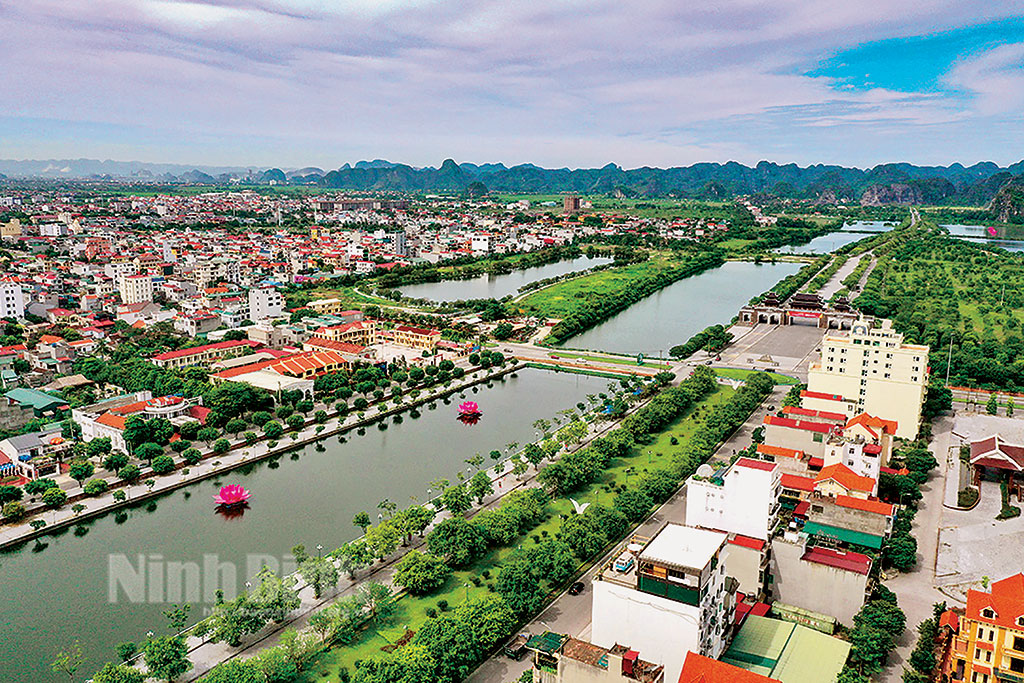Ninh Binh set to build ancient capital - heritage urban area

Over 30 years ago when Ninh Binh was re-established, its economy was quite poor and mainly relied on agriculture.
Right at that time, the provincial Party Committee clearly defined tourism and services as an important economic sector.
According to Dinh Duc Huu, Deputy Director of the Department of Construction, in the early 2000, the provincial Party Committee issued resolutions on developing tourism. This laid a foundation and a momentum for Ninh Binh to successfully seek UNESCO's recognition of Trang An as a natural and cultural heritage in 2014.
Also in 2014, Ninh Binh submitted a master urban planning project of Ninh Binh to 2030 with a vision to 2050.
According to the orientation of developing space, Ninh Binh's urban area is designed to be a polycentric urban area comprising a central urban area of Ninh Binh city and Thien Ton town, while auxiliary urban areas of Bai Dinh, Ninh Hai - Ninh Thang, Ninh Van and Mai Son connect each other by transport system and Trang An landscape area; the ecological agricultural area served as a buffer zone to protect Trang An and to limit the expansion of urban centres.
Right after the planning project was approved by the Prime Minister, Ninh Binh has devised solutions to develop urban areas in parallel with preserving heritage values sustainably.
In particular, the provincial Party Committee has issued Resolution No 16-NQ/TU on the re-arrangement of administration units at the district and commune levels for the period of 2023-2030.
Accordingly, by 2025, the district of Hoa Lu will be merged into Ninh Binh city. The newly rearranged administration unit will be featured with "urban of ancient capital - heritage" based on outstanding natural, historical and cultural values of Trang An.
The newly re-arranged administration unit will complete criteria of the provincially run tier-I urban area, to be a tourism hub of the region and Vietnam and become a political-administrative, cultural, economic, educational, scientific-technological and hi-tech service center.
Architect Nguyen Trung Dung, Vice Director of the Ninh Binh Institute of Planning - Construction, said that there is a clear separation between a modern urban area and Trang An landscape complexso that Ninh Binh must clarify the parallel tasks of developing a modern urban area and preserving heritage. In order to develop a unique urban area of Ninh Binh that bears outstanding features of ancient capital-heritage, it needs to zone off specific urban area, surrounding areas between the urban area and Trang An heritage.
It must calculate the building density and architecture structure as well.
It is necessary to have a general model of architecture for public buildings, residential areas and service houses in the surrounding areas to not break the landscape and traditional values in the urban area.
Professor Dr.Nguyen Quang Ngoc, Vice Chairman of the Vietnam Historical Science, said Hoa Lu - Ninh Binh urban area has been expanded or narrowed over the past 1,000 years. These changes had been based on the core of Hoa Lu ancient capital.
When Trang An was recognised as a world cultural and natural heritage in 2014, the high demand for the development of tourism, culture and cultural industry has sped up the urbanization in rural areas, gradually helping rural and urban areas of Hoa Lu ancient capital approach the urban model of ancient capital - heritage.
The outstanding values of the first capital of Dai Viet state, the unique position of Hoa Lu ancient capital that leans against mountains, with the view of Hoang Long river, head to the East Sea have offered typical values of historical-cultural space for Hoa Lu, and lay a strong drive for Ninh Binh to turn itself into an ancient capital -heritage urban and a centrally run city in the Red River Delta.
This is also a key content and lays an important foundation for Ninh Binh to define urban brand name of Hoa Lu - Ninh Binh in its development orientations to 2030 with a vision until 2045.
Translated by Nguyen Thuy


